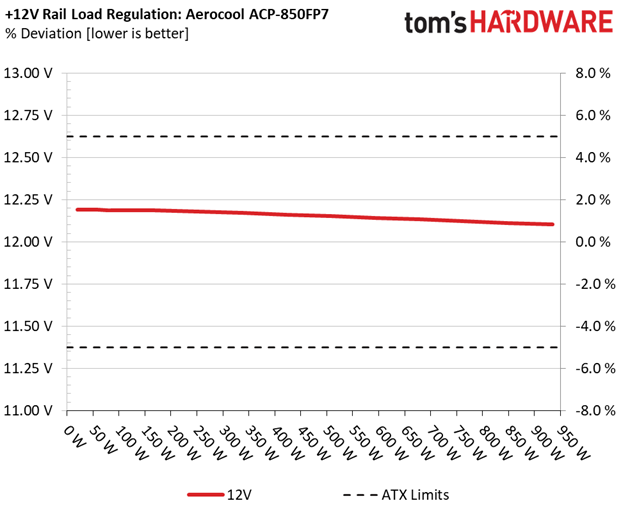Aerocool Project 7 850W PSU Review
Why you can trust Tom's Hardware
Load Regulation, Hold-Up Time & Inrush Current
To learn more about our PSU tests and methodology, please check out How We Test Power Supply Units.
Primary Rails And 5VSB Load Regulation
Load Regulation testing is detailed here.








Hold-Up Time
Our hold-up time tests are described in detail here.







The hold-up time we measure comes close to 20ms, while the power-good signal is accurate (it drops 1.9ms before the rails go out of spec).
Inrush Current
For details on our inrush current testing, please click here.


The inrush result is normal for a 850W PSU.
Load Regulation And Efficiency Measurements
The first set of tests reveals the stability of the voltage rails and the ACP-850FP7's efficiency. The applied load equals (approximately) 10 to 110 percent of the PSU's maximum load in increments of 10 percentage points.
Get Tom's Hardware's best news and in-depth reviews, straight to your inbox.
We conducted two additional tests. During the first, we stressed the two minor rails (5V and 3.3V) with a high load, while the load at +12V was only 0.1A. This test reveals whether a PSU is compatible with Intel's C6/C7 sleep states or not. In the second test, we determined the maximum load the +12V rail could handle with minimal load on the minor rails.
| Test # | 12V | 5V | 3.3V | 5VSB | DC/AC (Watts) | Efficiency | Fan Speed | Fan Noise | Temps (In/Out) | PF/AC Volts |
|---|---|---|---|---|---|---|---|---|---|---|
| 1 | 5.184A | 1.976A | 1.954A | 0.990A | 84.747 | 88.776% | 0 RPM | <6.0 dB(A) | 44.13°C | 0.938 |
| 12.188V | 5.058V | 3.372V | 5.031V | 95.462 | 38.41°C | 115.21V | ||||
| 2 | 11.385A | 2.960A | 2.937A | 1.190A | 169.602 | 92.562% | 0 RPM | <6.0 dB(A) | 44.76°C | 0.972 |
| 12.188V | 5.057V | 3.368V | 5.026V | 183.231 | 38.65°C | 115.23V | ||||
| 3 | 17.962A | 3.467A | 3.445A | 1.391A | 254.857 | 92.779% | 0 RPM | <6.0 dB(A) | 45.65°C | 0.977 |
| 12.179V | 5.055V | 3.365V | 5.018V | 274.693 | 38.86°C | 115.23V | ||||
| 4 | 24.531A | 3.956A | 3.924A | 1.595A | 339.711 | 92.488% | 0 RPM | <6.0 dB(A) | 47.32°C | 0.983 |
| 12.170V | 5.053V | 3.361V | 5.010V | 367.302 | 39.27°C | 115.23V | ||||
| 5 | 30.765A | 4.960A | 4.912A | 1.795A | 424.648 | 91.370% | 395 RPM | 6.5 dB(A) | 41.06°C | 0.988 |
| 12.161V | 5.049V | 3.357V | 5.004V | 464.756 | 55.50°C | 115.21V | ||||
| 6 | 37.017A | 5.946A | 5.904A | 2.000A | 509.595 | 90.812% | 395 RPM | 6.5 dB(A) | 41.64°C | 0.991 |
| 12.151V | 5.047V | 3.353V | 4.998V | 561.155 | 56.73°C | 115.21V | ||||
| 7 | 43.272A | 6.944A | 6.896A | 2.200A | 594.507 | 90.112% | 395 RPM | 6.5 dB(A) | 42.67°C | 0.993 |
| 12.142V | 5.043V | 3.349V | 4.993V | 659.741 | 60.74°C | 115.21V | ||||
| 8 | 49.545A | 7.937A | 7.891A | 2.405A | 679.459 | 89.160% | 1025 RPM | 27.8 dB(A) | 44.25°C | 0.994 |
| 12.132V | 5.040V | 3.344V | 4.985V | 762.067 | 56.96°C | 115.21V | ||||
| 9 | 56.257A | 8.446A | 8.409A | 2.405A | 764.566 | 88.544% | 1025 RPM | 27.8 dB(A) | 44.63°C | 0.995 |
| 12.122V | 5.036V | 3.341V | 4.985V | 863.487 | 58.23°C | 115.21V | ||||
| 10 | 62.717A | 8.942A | 8.896A | 3.020A | 849.340 | 87.693% | 1045 RPM | 28.2 dB(A) | 45.35°C | 0.995 |
| 12.112V | 5.035V | 3.338V | 4.965V | 968.538 | 59.12°C | 115.21V | ||||
| 11 | 69.767A | 8.946A | 8.905A | 3.020A | 934.250 | 86.579% | 1410 RPM | 36.4 dB(A) | 46.57°C | 0.996 |
| 12.105V | 5.034V | 3.335V | 4.963V | 1079.074 | 61.26°C | 115.21V | ||||
| CL1 | 0.097A | 14.027A | 14.004A | 0.004A | 118.996 | 86.427% | 395 RPM | 6.5 dB(A) | 43.80°C | 0.958 |
| 12.196V | 5.049V | 3.354V | 5.101V | 137.684 | 52.24°C | 115.22V | ||||
| CL2 | 69.934A | 1.004A | 1.002A | 1.001A | 861.033 | 87.731% | 1045 RPM | 28.2 dB(A) | 46.16°C | 0.995 |
| 12.120V | 5.040V | 3.348V | 5.012V | 981.447 | 60.92°C | 115.22V |
Load regulation is pretty tight on all rails, especially +12V, where Aerocool's PSU loses only to the less efficient EVGA 850 G3.
We also like that the noise output is kept amazingly low, even under high operating temperatures. The fan starts to spin during our fifth test and doesn't speed up through the seventh test. Fan noise increases quite a bit during test #8, but it remains under 30 dB(A). This continues through our full-load measurements. It takes overloading the PSU to make its fan spin fast enough to exceed 35 dB(A).
This is probably the quietest 850W power supply we've ever tested. Aerocool and Andyson deserve praise for their efforts here. We only hope that the conservative fan profile doesn't negatively affect reliability over time. Then again, we suspect Aerocool wouldn't include a seven-year warranty if it was concerned.
MORE: Best Power Supplies
MORE: How We Test Power Supplies
MORE: All Power Supply Content
Current page: Load Regulation, Hold-Up Time & Inrush Current
Prev Page Teardown & Component Analysis Next Page Efficiency, Temperature & Noise
Aris Mpitziopoulos is a contributing editor at Tom's Hardware, covering PSUs.


